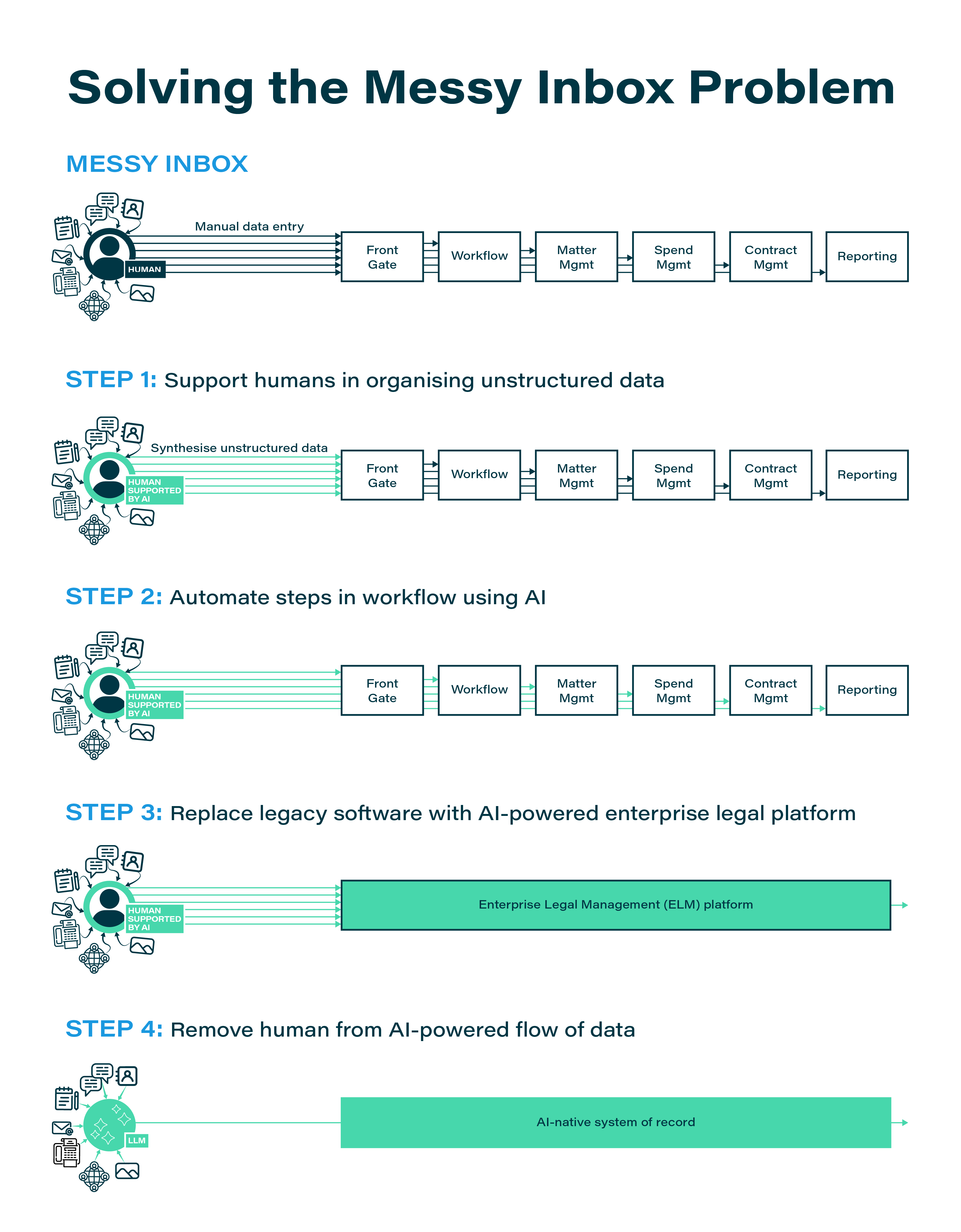Looking Back, Looking Forward: The 2025 Edition
January 23, 2025
legal tech trends legal operations innovation artificial intelligence future of law
With the arrival of the new year, I once again take stock of the year past and the one ahead – as I did at the start of 2024, 2023, and 2022.
Elevate’s 2024 Performance and Achievements
We gained over 200 new customers in 2024, split roughly evenly between law departments and law firms. Financially, Elevate grew by almost 20% to record revenue of $117 million and record EBITDA of $15 million in 2024. We also achieved a net promoter score of 42, well above the average for the legal sector.
Elevate made headlines – some in partnership with customers. Notable announcements included:
- a multi-year agreement with global law firm Ashurst to build and operate its new Advance Global Delivery Centre in Krakow, Poland
- our selection by global law firm Herbert Smith Freehills to run and manage its newly launched enhanced alumni talent network
- our acquisition of The CJK Group, a specialist provider of Chinese, Japanese, and Korean language support for litigation, investigations, and due diligence
- our acquisition of Redgrave Data, a pioneering Chambers Band 1 NewLaw legal data and AI consulting and technology services company
- the $20 million growth investment we received from Runway Growth Capital (building on a previous investment of $40 million in 2023)
Elevate and our customer collaborations continue to receive recognition within the legal industry and beyond. For the ninth consecutive year, Chambers gave Elevate Band 1 (the highest) rankings in all eligible categories, naming Elevate a top provider in Contract Lifecycle Management, Flexible Legal Staffing, and Litigation Services. Elevate won Theorem Legal Marketplace’s award for Top Solution Provider in the Tech Enabled Service + ALSP category of the 2024 Legal Tech TAM Awards. And, with an innovative, expert-led, AI software-powered Elevate solution, LegalOps.com named an Elevate Fortune 100 customer a winner of the inaugural Running Legal Like a Business Awards for ’Excellence in Legal Operations.’ Beyond industry recognitions, Newsweek recognised Elevate as one of America’s Greatest Workplaces for 2024, as well as naming it among America’s Greatest Workplaces in 2024 for both Diversity and Mental Well-Being.
This year, I’d like to share my thoughts about the current and future state of two important trends in law: Legal Ops and AI.
My Current POV on Legal Ops
Mary O’Carroll (Goodwin COO, ex-CLOC President, ex-Ironclad Chief Community Officer, ex-Google Legal Ops) asked a provocative question on LinkedIn recently: Is Legal Ops at a Crossroads? Are We Losing Momentum?
There is an increasing sentiment among legal operations professionals that their roles are not strategic to the law department. Additionally, growing evidence suggests that positions are being eliminated without being backfilled or that the scope of roles is being narrowed.
My response to Mary’s question is that many of my close senior legal ops and GC friends have discussed this issue for nearly four years. GCs who have secured a C-suite business role have almost always collaborated closely with a successful legal ops executive. While those successful legal ops executives may have been senior, that was not a requirement. But they all created a plan that resonated with the business and end customers to gain their buy-in and then delivered on it, demonstrating results that the business and end customers valued.
When I am asked by a legal ops executive who feels like they are pushing a rock uphill, my advice typically includes: ‘Stop creating plans that promote your personal interests or the interests of legal ops; stop purchasing software; and stop hiring staff. Start understanding why you were hired and what your GC wants you to achieve.’ If they are unclear about what they want from you, or if you must produce a roadmap in a vacuum, which they merely acknowledge, you may find yourself in your position for just a few years. You will work hard, yet your accomplishments won’t be significant: be realistic and strive to understand how you can assist the business and end customers reach their objectives.
Prioritise their needs, focus on the most impactful projects in the proper sequence, establish realistic timelines and KPIs that matter, secure genuine executive sponsorship and support for your business case and milestones, and then embark on the challenging work of change, which is fundamental to the legal ops role. Change doesn’t mean dictating how lawyers should work or which new tools to adopt. It means meeting them where they are, presenting a credible vision of how tomorrow will be better than today, breaking the journey into manageable steps to mitigate risk, recognising their objections and fears, winning over the coalition of the willing, and being pragmatic about accumulating wins for them while also sharing stories with data that the GC can present to the CFO, CEO, and other C-suite colleagues about how the law department is making a difference.
To achieve this, you must thoroughly understand the current state of and design the future business processes, data, inputs, and outputs. Additionally, you must conduct early-stage process and data improvements before purchasing any software. The software you currently have or may acquire later must support and enhance the new, improved operational methods. It should enable automation, simplification, and insights.
This tried-and-true framework fosters sustainable operationalisation in Global 2000 law departments. I have witnessed it succeed time and again. We conduct pre-mortems with customers before engagements (‘Why are you hiring us?’) and after-action reviews of projects and programs with customers (‘What went well and what can we look at improving?’). The data we collect illustrates a compelling narrative: this approach is highly correlated with success. Alternative paths may yield similar results, but they are often littered with project failures and potential reputational or career harm. Nearly every legal ops executive and GC pursuing this path (or a similar one) has generated results, often receiving recognition in the C-suite or boardroom, and has witnessed their career flourish.
Legal ops is vital to the business, just like sales ops, people ops, and others. Yet, we have done our community a disservice by promoting shortcuts, unnecessary software, and activities that don’t deliver results that the business or end customer cares about. I have warned my close legal ops friends that this issue will not be resolved by grumbling that ‘the GC [or the business] doesn’t understand or value me.’ Instead, go make a dent in the universe. But make sure your dent matters!
My Current POV on AI and LegalTech
I won’t add to the predictions of which legal use cases best suit AI-ification (a made-up word), but I would like to comment on how this might unfold. Will AI integrate with existing legal tech, or will AI-native software leapfrog and eliminate legal tech?
David Haber (general partner at Andreessen Horowitz) wrote a thought-provoking blog, The Messy Inbox Problem: Wedge Strategies in AI Apps, arguing that AI-native applications across verticals will replace judgment-intensive human work with LLMs. He and I agree that countless hours are wasted gathering unstructured information from multiple sources (the ‘messy inbox’), then (re-) entering that data into industry-specific systems of record to perform the work. David argues that replacing this human labour with LLM steps before downstream software systems to synthesise the unstructured data and extract relevant information allows the LLM to initiate (and own) the downstream workflows. This is the wow! promised by some of the legal AI platforms that have signed up numerous customers (you’ve all read the blizzard of press releases). Some of these AI-native companies are attracting dot-com levels of funding. Andreessen Horowitz recently led a $47m investment into Eve. Personal injury AI company EvenUp has raised $235m and boasts a $1B valuation. This is one vision for AI in law. And it is one path to success.
I was a dot-com legal tech founder who raised $20 million from Sutter Hill, Adobe Ventures, and Trident on Sand Hill Road in 1998. I sold my company just before the dot-com crash. That experience taught me many lessons. So, Elevate is pursuing a different vision for AI in law—one that is capital-efficient, sustainable, and executable, which I believe our stakeholders care about. Over the past decade, we have done the heavy lifting of processifying (another made-up word) legal work such as contract negotiation, spend management, and responding to medical claims. We deliver this routine work for a fixed price per unit (e.g., per contract, $ spent with outside counsel, or medical damages report). We have developed a method or process for doing the work and then disaggregated it so that the right people, with the right skills, in the right locations (we have a global footprint of nearly 2,500 Elevaters) can perform the work cost-efficiently. Oh, but that was so five years ago! Since then, we have built a legal software system of record (our ELM platform) for data, workflow, and reporting, digitising our service delivery. Oh, but that was so last year! Borrowing from David Haber, you will see how Elevate is applying AI in law in the graphic below. I have included some typical workstreams in law in my graphic, which you should not interpret strictly as flowing from one step to another, but rather to illustrate the concept of ELM as a system of record for law.

Step 1: Today, humans initiate the process, determine which data sources are relevant, and engage or oversee throughout. AI synthesises data from relevant sources and structures it in our ELM software.
Step 2: Today, AI automates workflow steps to do some of the work. We use an LLM for generative steps, such as contract redlining or producing the first draft of a medical claims report summary. For predictive steps, we might use ML to classify information accurately.
Step 3: In the near future, AI agents will perform multiple steps autonomously, doing most of the work and eliminating the need for workflow software. Humans will still oversee decisions, and workflow software will continue to be an essential navigation and engagement tool for users of the software for some time.
Step 4: Over the horizon. I don’t believe removing and replacing humans with self-driving, fully autonomous AI will achieve the consistent accuracy that lawyers and end customers demand anytime soon.
Since many others have already done so, I won’t comment on the constraints to AI adoption due to resistance to law firm business model change. However, I want to highlight two future constraints that I believe are responsible to keep in mind.
First, we should not automate work that humans find fulfilling or enjoyable. We have established a policy that while we can and should use AI to automate and expedite routine, tedious tasks that humans cannot perform at speed and scale, we should not rob people of the kind of work that gets them out of bed in the morning. It is crucial to find the right balance between efficiency and engagement. Demonstrating to our people that they have more of the work they want to do has helped them support adoption and allows us to develop an AI-skilled and happy workforce, prepared for the future.
Second, we must consider the full cost of computation. Thoughtlessly using LLMs for steps best executed by ML (or even a human) incurs both a financial cost and an environmental cost—in terms of power and water—and I believe future generations will appreciate our consideration of this.
In Closing
I’d like to thank my colleagues for all your work, and our customers for all your trust. 2024 was a successful and fulfilling year and I look forward to an exciting 2025 for Elevate, for legal ops, and for legal tech.
Back to Expertise


